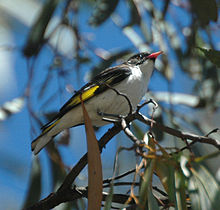Grantiella
| Painted honeyeater | |
|---|---|
 |
|
| Scientific classification | |
| Kingdom: | Animalia |
| Phylum: | Chordata |
| Class: | Aves |
| Order: | Passeriformes |
| Family: | Meliphagidae |
| Genus: |
Grantiella Mathews, 1911 |
| Species: | G. picta |
| Binomial name | |
|
Grantiella picta (Gould, 1838) |
|
 |
|
| Distribution of the painted honeyeater Deeper Red Indicates Breeding Range |
|
The painted honeyeater (Grantiella picta) is a species of honeyeater in a monotypic genus.
Weighing around 20-25g, the painted honeyeater is a small bird that is approximately 16 cm in length, with a wingspan of a similar length. Of the total length, the tail averages about 5.5 cm long and the bill 1.3 cm.
The face, crown and upper parts of the body (including the scapulars, nape and rump) on adult male birds are black, with small white spots located on either side of the head. The underside of the body, consisting of the chin, throat, breast and belly, as well as the underside of the tail, is white. Black spots may be present in amongst the white feathers of the flanks, breast and belly.
The edges of black flight feathers and greater primary and secondary coverts are bright yellow, as are those of the tail feathers, which also have white tips. The striking colour contrast in the feathers of the remiges and retrices is one of the species' most distinctive traits, along with its pink bill, which has a grey tip. Feet and legs are also grey, while the irises of the eyes are reddish-brown .
Females are slightly smaller than the males and are paler in colour, with fewer spots running down the flanks. Juveniles are even paler than the female, appearing more brown than black, with fainter yellow colouring to feathers and with a grey bill rather than the pink seen on adults.
Commonly known to give the call “Georgie”, which is broken into two notes, for example geor-gie or georg-EEE. This can also be done in reverse. Males can be particularly vocal during courtship and both sexes are known to call when in flight during the breeding season as they leave and approach the nest.
Some birds may quieten down once nesting has begun or give softer calls as they are approached by people, or when they are settling down on the nest. A call sounding like “chur”, has been recorded and associated with movement into and out of the nest, possibly signalling relief at returning to the nest.
Under the threat of predation they also give out alarm calls, both males and females using differing intensity calls depending on the situation, a more urgent call being sounded when eggs are being stolen.
A member of the Meliphagidae family, Grantiella picta is the sole species under this genus. The painted honeyeater was first described in 1838 by Gould and given the name Entomophila picta, but it was renamed Grantiella picta in 1911 by Mathews.
...
Wikipedia

